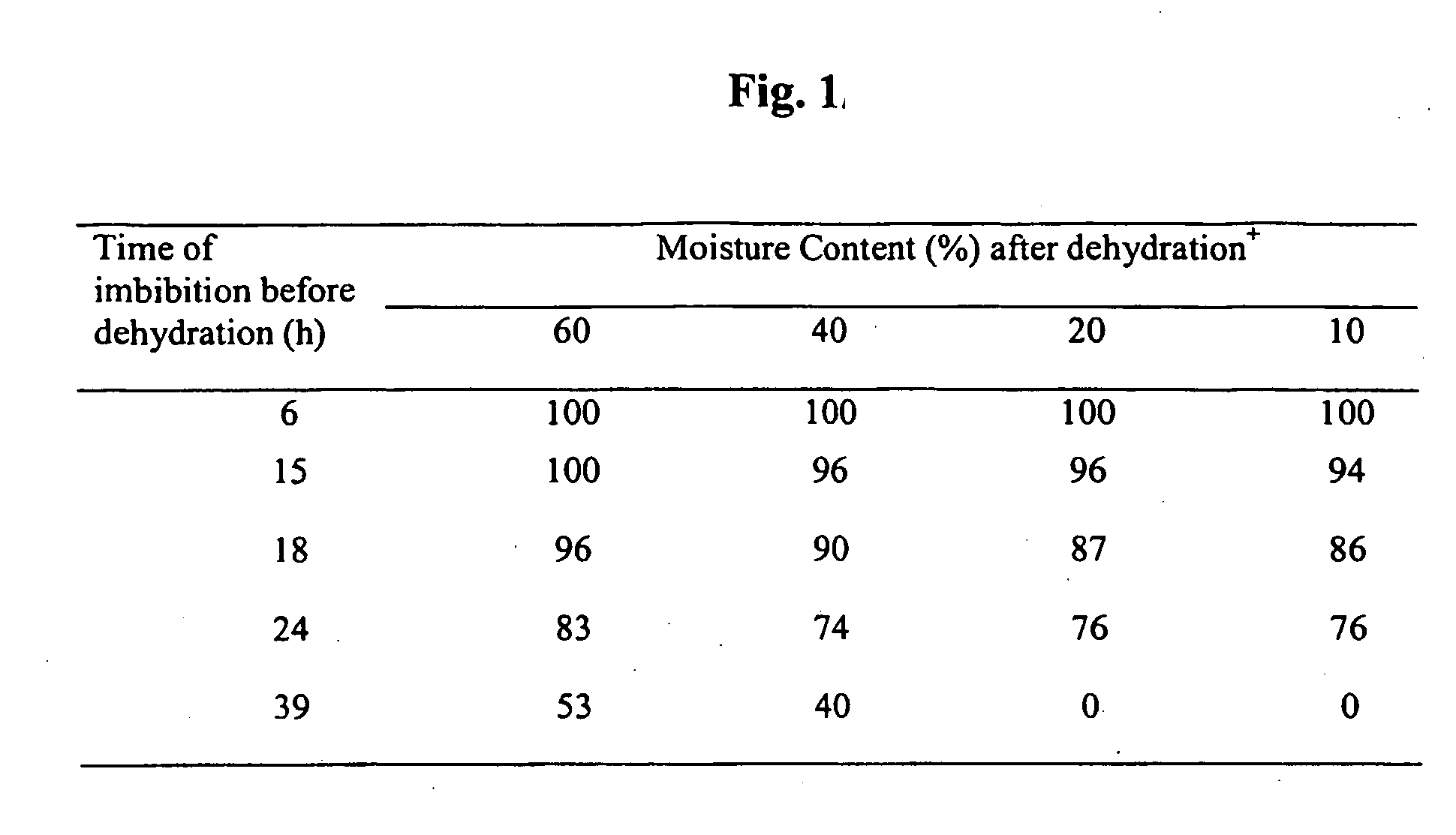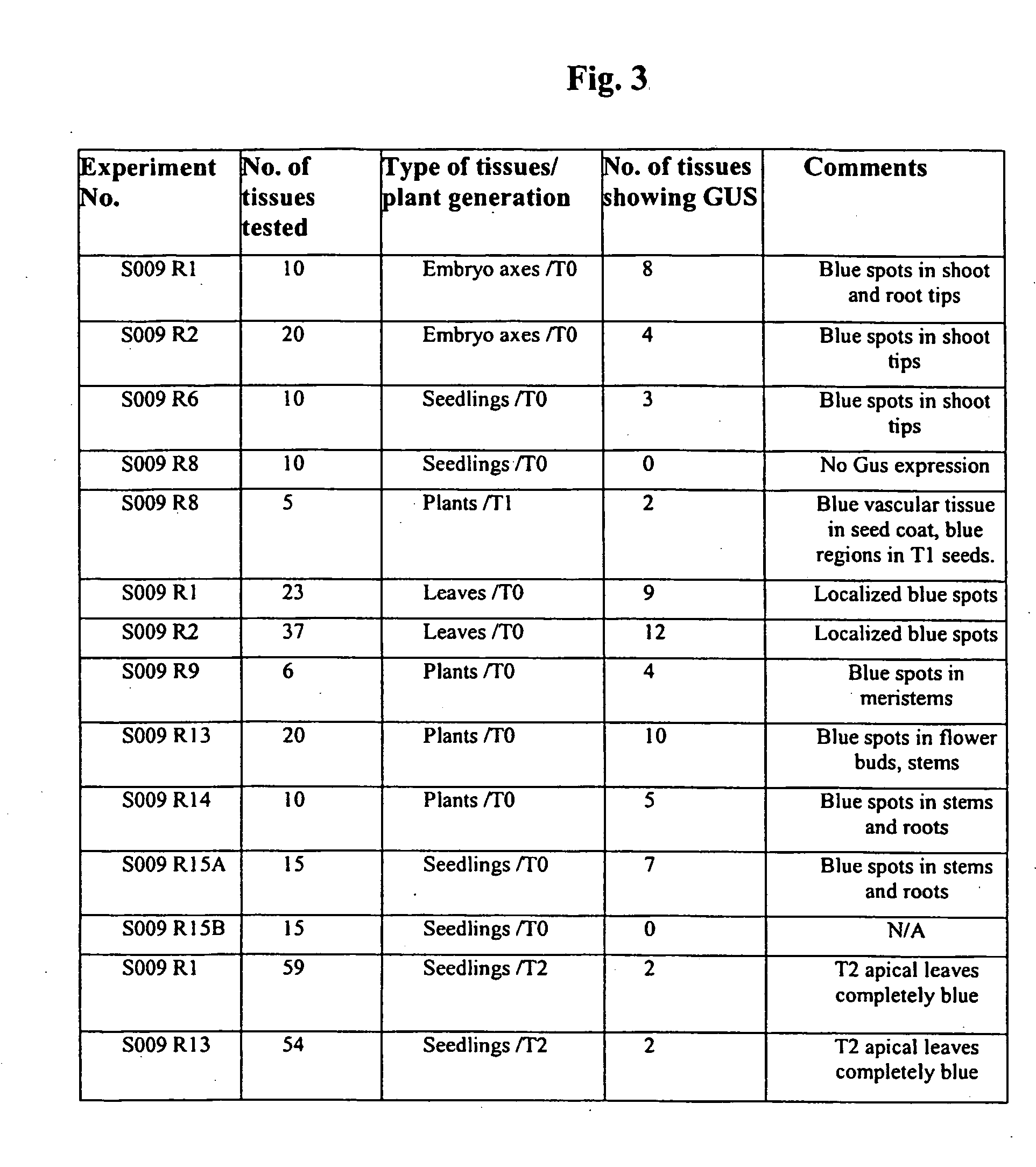In planta transformation by embryo imbibition of agrobacterium
a technology of agrobacterium and planta, which is applied in the field of plant transformation by embryo imbibition, can solve the problems of neoplastic growth (tumor) on the host plant, low frequency of stable transformation, and deleterious changes to other traits of the targeted cell
- Summary
- Abstract
- Description
- Claims
- Application Information
AI Technical Summary
Benefits of technology
Problems solved by technology
Method used
Image
Examples
example 1
[0048] Soybean
[0049] Soybean seeds were surface sterilized with 70% ethanol for 4 minutes with continuous shaking, followed continuous shaking in 20% (v / v) Clorox™ supplemented with 0.05% (v / v) Tween 20™ for 20 minutes. Unless otherwise indicated, these examples were performed at room temperature. The seeds were then rinsed 4 times with distilled water and placed on moistened sterile filter paper in a Petri dish at room temperature for 6 to 39 hours. The seed coats were peeled off, and one or both cotyledons were detached from the embryo axis. The embryo axis was examined to make sure that the meristematic region was not damaged. The excised explants were collected in a half-open sterile Petri dish and air-dried. During this period, the embryo loses approximately 40 to 90% of its water content.
[0050] In one experiment, the soybean seeds were imbibed in water for 6 to 39 hours before the seed coats were removed and the embryo axes (with no cotyledons or with one cotyledon) were exc...
example 2
[0059] Canola
[0060] The method of plant transformation described in Example 1 is also applicable to Brassica and other crops. To illustrate this principle, seeds of canola were surface sterilized with 70% ethanol for 4 minutes at RT with continuous shaking, followed by continuous shaking in 20% (v / v) Clorox™ supplemented with 0.05% (v / v) Tween 20™ for 20 minutes at RT. The seeds were then rinsed 4 times with distilled water and placed on moistened sterile filter paper in a Petri dish at room temperature for 18 hours. Then the seed coats were removed and the seeds were air dried overnight in a half-open sterile Petri dish. During this period the seeds lost approximately 85% of their water content. The seeds were then stored at RT in a sealed Petri dish until further use. DNA constructs, embryo axis imbibition and in situ uidA gene expression were as described in Example 1. The histological analysis of the uidA gene expression in canola is shown in FIG. 5.
[0061] Samples of the prima...
example 3
[0063]Arabidopsis
[0064] This method of transformation is also applicable to whole intact seeds as shown in this example using Arabidopsis. Seeds of Arabidopsis thaliana are surface sterilized as explained in Example 1. The seeds are then rinsed 4 times with distilled water and placed on moistened sterile filter paper in a Petri dish at room temperature for up to 40 hours. The imbibed seeds are collected in a half-open sterile Petri dish and air dried. During this period the embryo may lose up to 90% of its water content.
[0065] In one experiment, the seeds are imbibed in water for 6, 12, 18, 24 or 36 hours, and dehydrated to various water contents. Some seeds were immediately placed on moist germination paper. Seed germination is affected by the dehydration treatment in a manner similar to that described in FIG. 1. The remaining seeds were imbibed in an Agrobacterium tumefaciens culture prepared as explained in Example 1. The seeds with approximately 15% moisture content are imbibe...
PUM
| Property | Measurement | Unit |
|---|---|---|
| temperature | aaaaa | aaaaa |
| concentration | aaaaa | aaaaa |
| concentration | aaaaa | aaaaa |
Abstract
Description
Claims
Application Information
 Login to View More
Login to View More - R&D
- Intellectual Property
- Life Sciences
- Materials
- Tech Scout
- Unparalleled Data Quality
- Higher Quality Content
- 60% Fewer Hallucinations
Browse by: Latest US Patents, China's latest patents, Technical Efficacy Thesaurus, Application Domain, Technology Topic, Popular Technical Reports.
© 2025 PatSnap. All rights reserved.Legal|Privacy policy|Modern Slavery Act Transparency Statement|Sitemap|About US| Contact US: help@patsnap.com



